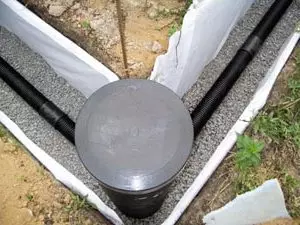
One of the main problems of any land plot is the oversupply of moisture in the soil. As a result, such unpleasant processes like stagnation of water on the plot, flooding of the basement, the blur of the soil, the rotor of the roots of trees and shrubs, premature destruction of the foundation of buildings. You can cope with the abrasiveness of moisture, having equipped drainage on the site with your own hands. For all rules, the constructed drainage system levels most of the problems associated with the rebupping of soil moisture.
Drainage and Application
The drainage system can be created on any plot. It consists of areas located on the territory of the pipe or channels, wells and system protection elements. Such a system for collecting infiltrated and soil moisture is intended, as well as for its lead to a certain place or beyond the site.The drainage device on the plot is necessary in the following cases:
- Plugging site. The water arriving on the surface of the soil does not have time to get absorbed into the ground, resulting in puddles, and the soil itself loses its porous structure. Especially relevant for clay soils;
- In the event of damp or flooding in the basement of the house or in the basement;
- If the foundation and walls of the structure began to be covered by cracks arising from the soil transfer;
- If window or doorways twisted;
- Washing soil from under the paths, paved sites;
- If the site is located on the hillside or in lowland.
Tip: Creating a drainage system is very desirable if the groundwater on your site is at a depth of 1.5 m or less.
Types of drainage systems
Depending on the design and degree of blocking of the elements of the system, two varieties of drainage systems differ:
one. Surface drainage . It is characterized by the location on the site of the network of channels, removing moisture falling in the form of precipitation. The surface drainage of the site can be made in two versions:
- Linear . This is a network of drainage gutters installed in trenches on a gravel pillow. All gutters have a bias towards the water collector about 3 degrees. On the channels, water merges into wells or sent beyond the boundaries of the site. All gutters are covered with lattices in order to protect them from garbage;
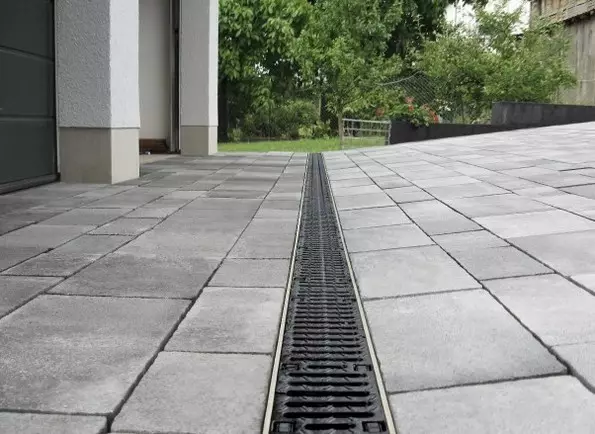
On the photo Surface linear drainage from drainage trays
- Cotton . This is a water receiver, which merges the water with straight from the drain pipe. Such rain-seekers may be somewhat. All of them are connected by the system of vertical and horizontal pipelines with storm sewer.
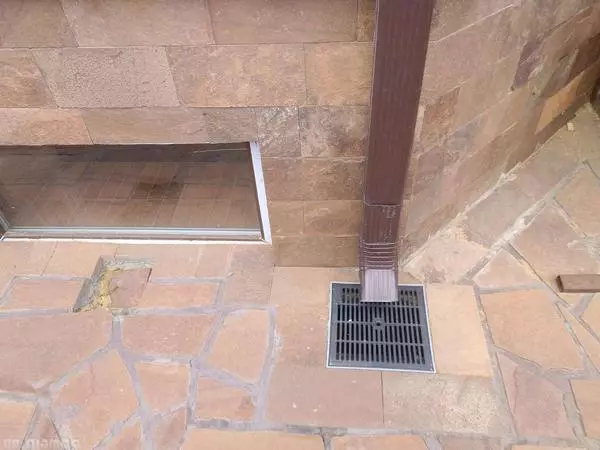
Point drainage is often used in combination with linear
2. Depth drainage . Such a structure is a system of perforated pipelines laid at some depth, below the soil level. The deep drainage on the site, made with their own hands, is perfectly coping with drainage on clay soils, as well as in the presence of surface groundwater.
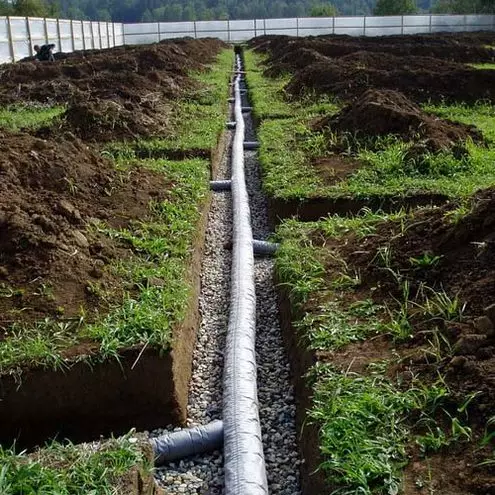
How the deep drainage of the plot is done with their own photo shows visual
Preparation of the draft drainage system
When the drainage diagram of the site is prepared, several nuances should be taken into account, since the efficiency and durability of the drainage system depend on the project.ATTENTION NOTE TO POINTS:
- Locking the drainage system is always fulfilled, after the end of gross construction works. Construction equipment located on the site can damage the elements of the surface drainage;
- The project must be indicated by all other communications to align them with the drainage system;
- It is necessary to know the level of occurrence on your section of groundwater;
- Explore the composition and structure of the soil on the site at different depths;
- The project should take into account the presence of structures overwhelmed in the land. It may be the ground floor at home, cellar, basement, well;
- Consider the facilities of the area;
- Drainage of the garden plot should be carried out with the location of shrubs and trees;
- Take into account the number of drop-down sediments in relation to your area.
What will be needed for open and closed drainage
Proper drainage in the country area with their own hands implies the use of certain types of building materials. Drainage systems will need different components.
1. To create a surface drainage may be required (depending on the type):
- rain-seekers;
- Polymer concrete / polymerpess or plastic trays for which water will flush in the place allotted;
- sandwokers who serve to prevent different garbage from entering the system;
- lattices made of metal or plastic, which will be covered with drainage trays;
- Sand, from which the underlying pillow for gutters and cement will be made to fix them.
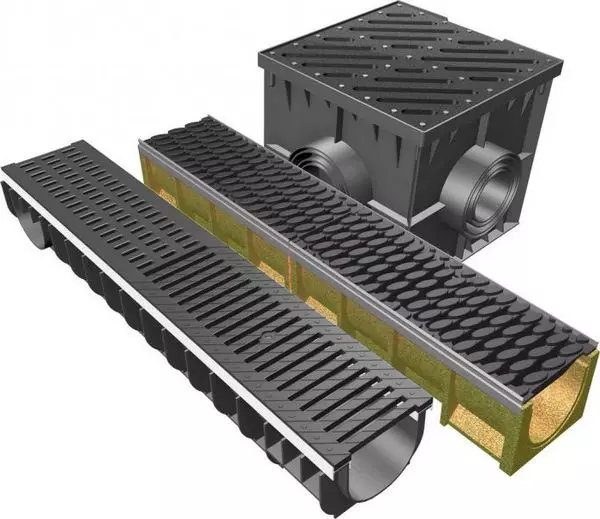
Drainage trays from different materials and rain
2. For the deep system, you will need to purchase:
- Pipe perforated, in which water will be gathered. It is best to use polymeric products. If they do not have holes, they will be drilled alone. The diameter of the pipes should not be less than 10 cm;
- geotextile, which will serve as a filter element;
- fittings and couplings for connecting pipes into a single system;
- Watching wells, thanks to which it will be possible to inspect the system and clean it;
- collector wells in which allotted water will accumulate;
- A pump by which water pumping from waterborne wells will be pumped out if such is planned to be built;
- sand for the arrangement of the underlying layer;
- Crushed stone for dumping and pre-filtration of water.
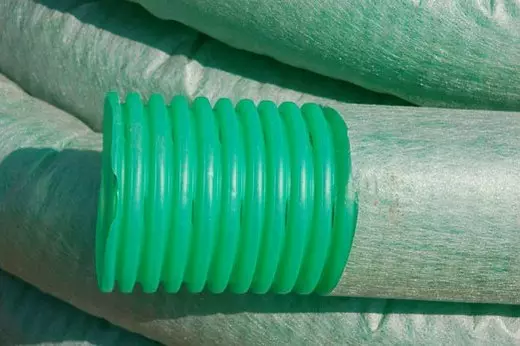
Perforated drainage tube with a filter from geotextile
Note: If you have a crusher deficiency, it is quite acceptable to use gravel. The basic condition - its separate stones should not be more than 4 cm in diameter.
Production of surface drainage system
Before making the drainage of the site with their own hands, it is necessary to make a scheme for the placement of all drainage channels. It is indicated by the location of the main (main) channels, which go to the collector well or water. In addition, additional channels are placed, removing water from individual places where it accumulates. Additional channels have a bias towards the main channels, connecting with them.Next you need to choose Type of linear drainage - falling (used rarely) or tray . Preparatory work for their identical:
- Strictly according to the diagram, trenches are digging. Their depth is 50-70 cm, and the width should be about 40-50 cm. Pay attention to the inclination of the trench walls. They must be mowed at an angle about 25 degrees. That is, at the top they are wider;
- The bottom of tranches is trambed.
Tip: Main channels are manufactured wider, as it will pass the flow of water collected from additional channels.
Fucking drainage
- In the trench, the layer of geotextiles is paired, after which the trenches fall asleep with rubble. The lower layer of rubble must have larger fractions. The geotextile is worst so that the soil particles do not get into the crushed stone layer;
- On top of such a backfill, the Earth is poured or the turf is stacked.
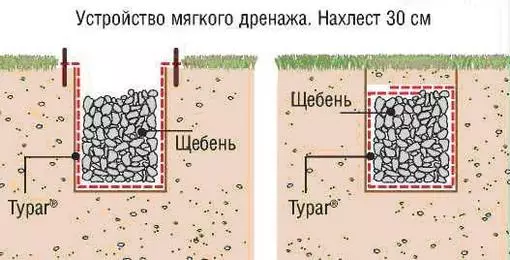
Scheme of the device of a falling drainage of the land
Train drainage
- Also digging trenches, but less depth;
- On the bottom of the trenches, the sand is covered with a layer of 10 cm;
- If desired, on top of the sand can pour rubble;
- At the bottom and the walls of the trench, cement mortar is poured;
- trays and sands are installed;
- Trays are covered on top of protective lattices.
Installation of deep drainage
Such a system is manufactured with special care, as the correction of any shortcomings will be problematic. The deep drainage of the plot is considered difficult to calculate and labor-intensive operation.
Work is performed in such a sequence:
- The plan for laying drainage highways is written;
- 50 cm width trenches and a depth of 80-100 cm. The slope of trenches is provided by about 3 degrees towards the drainage;
- The bottom of the trenches is covered with sand (about 10 cm), which is rambling;
- A geotextile is stacked on top of sand with such a calculation so that its ends rise above the soil level;
- Inside the geotextile layer is covered with rubble. Layer thickness - about 20 cm;
- Perforated pipes are stacked on crushed stone;
- Pipes of pipes are connected to each other;
- A collective well is prepared. It is equipped at the lowest point of the site;
- Pipes are displayed in a drain well, from which water will pump or merge at a lower level;
- Purchased tubes are covered with rubble on top. It should not reach the soil level;
- Geotextile wraps, with the result that the pipe and crushed stone, which is around it, are in the "cocoon";
- From above, the whole design is covered with soil.
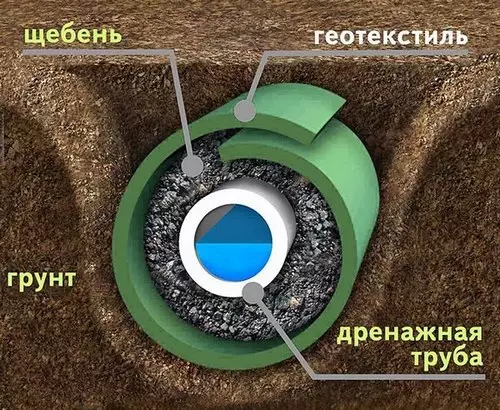
Drainage pipe laying scheme
The drainage system will transform your site, remove it from the excess moisture, restore the natural state of the soil.
Video
How to make drainage on the plot with your own hands, see the video. It addresses the option of non-open drainage, and the deep one.
Article on the topic: Installing eaves for curtains with your own hands
